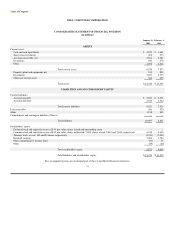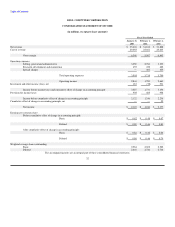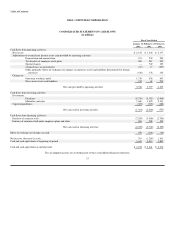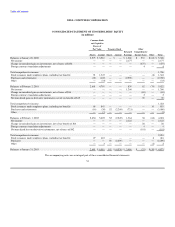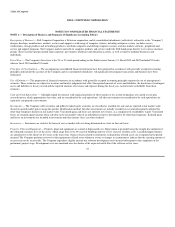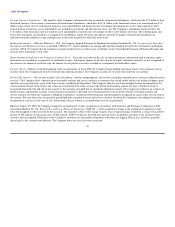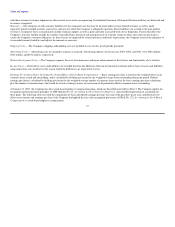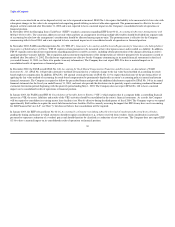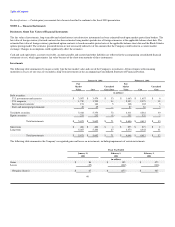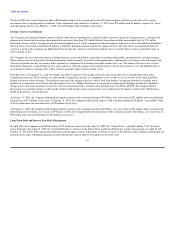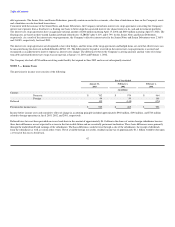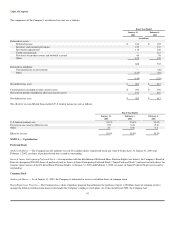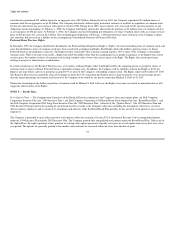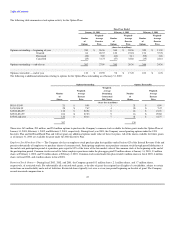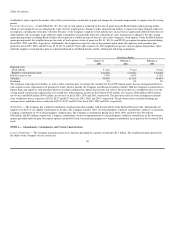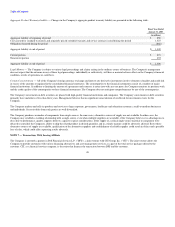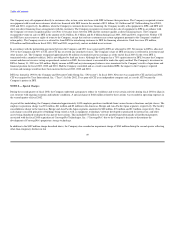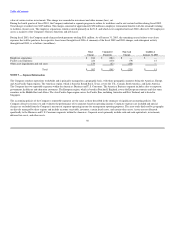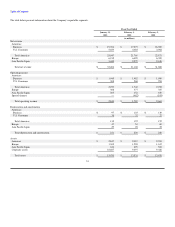Dell 2002 Annual Report Download - page 44
Download and view the complete annual report
Please find page 44 of the 2002 Dell annual report below. You can navigate through the pages in the report by either clicking on the pages listed below, or by using the keyword search tool below to find specific information within the annual report.
Table of Contents
The fiscal 2002 loss on investments includes a $260 million charge in the second quarter for other-than-temporary declines in fair value of its venture
investments due to ongoing market conditions. Gross unrealized gains and losses at January 31, 2003 were $74 million and $3 million, respectively. Gross
unrealized gains and losses at February 1, 2002 were $49 million and $16 million, respectively.
Foreign Currency Instruments
The Company uses purchased option contracts and forward contracts designated as cash flow hedges to protect against the foreign currency exchange risk
inherent in its forecasted transactions denominated in currencies other than U.S. dollar. Hedged transactions include international sales by U.S. dollar
functional currency entities, foreign currency denominated purchases of certain components and intercompany shipments to some international subsidiaries.
The risk of loss associated with purchased options is limited to premium amounts paid for the option contracts. The risk of loss associated with forward
contracts is equal to the exchange rate differential from the time the contract is entered into until the time it is settled. These contracts generally expire in
twelve months or less.
The Company also uses forward contracts to hedge monetary assets and liabilities, primarily receivables and payables, denominated in a foreign currency.
These contracts are not designated as hedging instruments under generally accepted accounting principles, and therefore, the change in the instrument's fair
value is recognized currently in earnings and is reported as a component of investment and other income (loss), net. The change in the fair value of these
instruments represents a natural hedge as their gains and losses offset the changes in the underlying fair value of the monetary assets and liabilities due to
movements in currency exchange rates. These contracts generally expire in three months or less.
If the derivative is designated as a cash flow hedge, the effective portion of the change in the fair value of the derivative is initially deferred in other
comprehensive income. These amounts are subsequently recognized in income as a component of net revenue or cost of revenue in the same period the
hedged transaction affects earnings. The ineffective portion of the change in the fair value of cash flow hedge is recognized currently in earnings and is
reported as a component of investment and other income (loss), net. Hedge effectiveness is measured by comparing the hedging instrument's cumulative
change in fair value from inception to maturity to the forecasted transaction's terminal value. During fiscal years 2003 and 2002, the Company did not
discontinue any cash flow hedges as substantially all forecasted foreign currency transactions were realized in the Company's actual results. Furthermore,
hedge ineffectiveness was not material.
At January 31, 2003, the Company held purchased option contracts with a notional amount of $2 billion, a net asset value of $31 million and a net unrealized
deferred loss of $37 million, net of taxes. At January 31, 2003, the Company held forward contracts with a notional amount of $2 billion, a net liability value
of $140 million and a net unrealized loss of $25 million, net of taxes.
At February 1, 2002, the Company held purchased option contracts with a notional amount of $2 billion, a net asset value of $83 million and a net unrealized
deferred gain of $11 million, net of taxes. At February 1, 2002, the Company held forward contracts with a notional amount of $2 billion, a net asset value of
$95 million and a net unrealized gain of $28 million, net of taxes.
Long-Term Debt and Interest Rate Risk Management
In April 1998, the Company issued $200 million 6.55% fixed rate senior notes due April 15, 2008 (the "Senior Notes") and $300 million 7.10% fixed rate
senior debentures due April 15, 2028 (the "Senior Debentures"). Interest on the Senior Notes and Senior Debentures is paid semi-annually, on April 15 and
October 15. The Senior Notes and Senior Debentures rank pari passu and are redeemable, in whole or in part, at the election of the Company for principal, any
accrued interest and a redemption premium based on the present value of interest to be paid over the term of the
41


